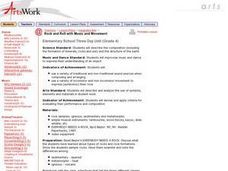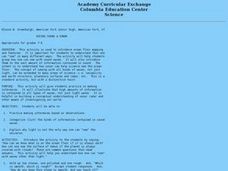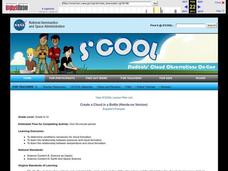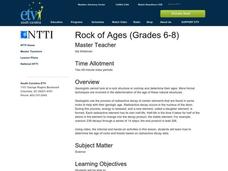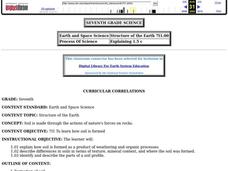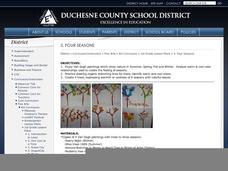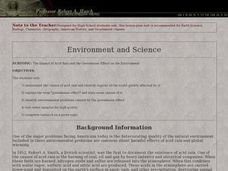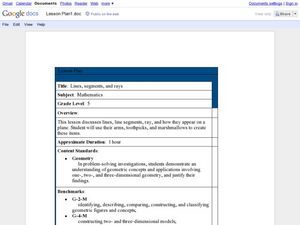Curated OER
Rock and Roll with Music and Movement
Fourth graders improvise music and dance to express their analysis of types of rocks. They discuss the three classes of rocks, list describing words, and create a short musical piece and dance to symbolize the rock they are dancing.
Curated OER
World History Worksheet # 7 Questions
What do we know about the ancient Mayan civilization? In this world history worksheet, students utilize a word bank of 10 terms or phrases pertaining to the Mayan and Olmec to answer 10 fill-in-the-blank questions about the...
Curated OER
Seeing Sound and Sonar
Middle schoolers grasp how underwater animals can "see" using sound waves. They practice making inferences, and build a conceptual understanding of sonar radar.
Alabama Learning Exchange
Our World is Like a Rainbow
Students create a Venn diagram of people's similarities and differences. They investigate why people relocate to different geographic regions after investigating the positives and negatives of different states.
Curated OER
Earthquake!
Students gain an understanding of earthquakes. They examine vocabulary associated with earthquakes, how earthquakes happen, and preventive measures taken to diminish damage or harm in the event that an earthquake should happen.
Curated OER
What's In A Name
Second graders read Chrysanthemum by Kevin Henkes. They then discuss where various names come from. They create a individualized biopoem and publish it on word processing software. Their poems are compiled into a class book and presented...
Curated OER
Create a Cloud in a Bottle
Students investigate the conditions needed for cloud formation and explore how pressure and temperature effect cloud formation. In this atmospheric pressure lesson students complete a lab on cloud formation.
Curated OER
The Fault Line
Students use cardboard models of the North American and Pacific plates and sand to investigate what happens when there is an earthquake or movement along the boundaries of the plates.
Curated OER
Plates on the Move
Learners explore how Africa appears to be tearing apart from Asia and tha the other continents are moving and oceans are changing size.
Curated OER
Volcanoes And Atmospheres
Students identify the volcano as the primary source of atmospheric gases, to explain the formation of ozone, and to recognize the dangers of volcanic gases through the use of technology in the classroom.
Curated OER
Rock of Ages
Students use a video, the Internet and hands-on activities to explore how to determine the age of rocks and fossils based on radioactive decay data.
Curated OER
Soil Formation
Seventh graders investigate how soil is formed. They analyze types of soil samples, examine soil using a magnifying glass or microscope, complete a chart, conduct a soil and plant experiment, and construct a soil profile.
Curated OER
What's the Connection Between Convection and Inversion?
Ninth graders observe a simulation demonstrating the difference between convection and inversion. They explain where and when convection and inversion layers occur and how each impacts air quality, and by connection, human health.
Curated OER
Four Seasons
First graders examine and describe the characteristics of the four seasons. Using a computer, they write one sentence about each of the four seasons and draws an illustration to accompany it. They present each drawing and sentence to the...
Curated OER
What Causes Earthquakes?
In this earthquakes learning exercise, students will read information about how different myths and legends have been created to describe the cause of earthquakes. Students will use this information to complete 3 short answer questions.
Curated OER
Astronomy
Students complete a unit of lessons on our solar system, its stars, and astronomers. They record information in a space journal, design constellations, define key vocabulary, observe the phases of the moon, and create a group planet...
Curated OER
Solar System: Let's Take a Trip
Third graders consider outer space. In this introductory solar system lesson, 3rd graders complete a KWL chart and listen to the story The Magic School Bus: Lost in the Solar System, by Joanna Cole & Bruce Degen. They will contribute...
Curated OER
Oceanography
Fourth graders define new vocabulary associated with oceanography. They locate and label the four oceans. They also identify features of the ocean floor.
Curated OER
Solar System
Second graders create planet mobiles in order to reinforce concepts such as planet size, position in relation to the sun, and planet names.
Curated OER
The Impact of Acid Rain and the Greenhouse Effect on the Environment
Students study acid rain and complete several activities that show how it affects the environment. They role play members of the community involved in a major decision involving the protection of the environment.
Curated OER
Volcano!-Thar She Blows!
Learners describe how volcanoes are formed. They name the types of boundaries where volcanoes occur. They utilize models to illustrate the occurence of volcanoes and earthquakes along plate boundaries. They compare and constrast the...
Curated OER
Earthquakes and Volcanoes
In this earthquakes and volcanoes worksheet, students will review how volcanoes are formed and where they are found. Students will describe earthquakes and their magnitudes. Students will use a table to answer questions about tsunamis....
Curated OER
Indians in Georgia
Students investigate technology used by Native Americans by examining their creations. In this Native American math lesson, students examine the overall area of Mississippian Indian mounds that were built hundreds of years ago....
Curated OER
Lines, Segments, and Rays
Fifth graders use their arm, toothpicks, and marshmallows to create lines, segments, and rays. In this lines, segments, and rays lesson plan, 5th graders learn how these appear on a plane.
